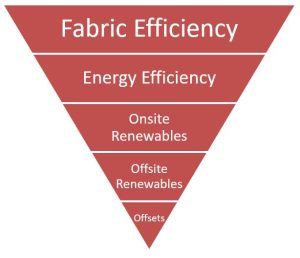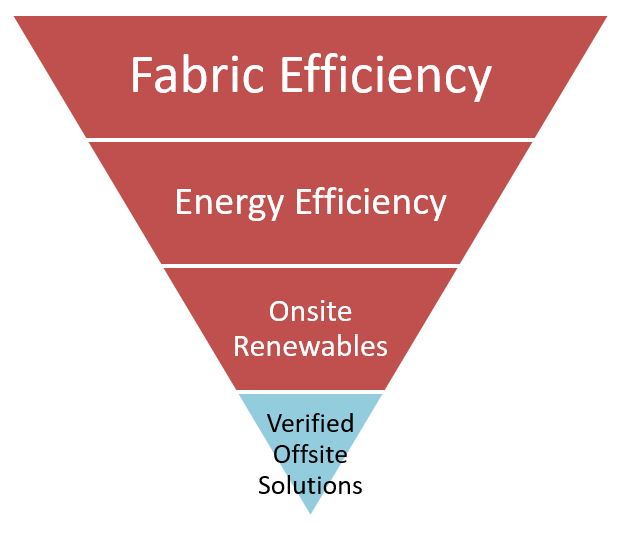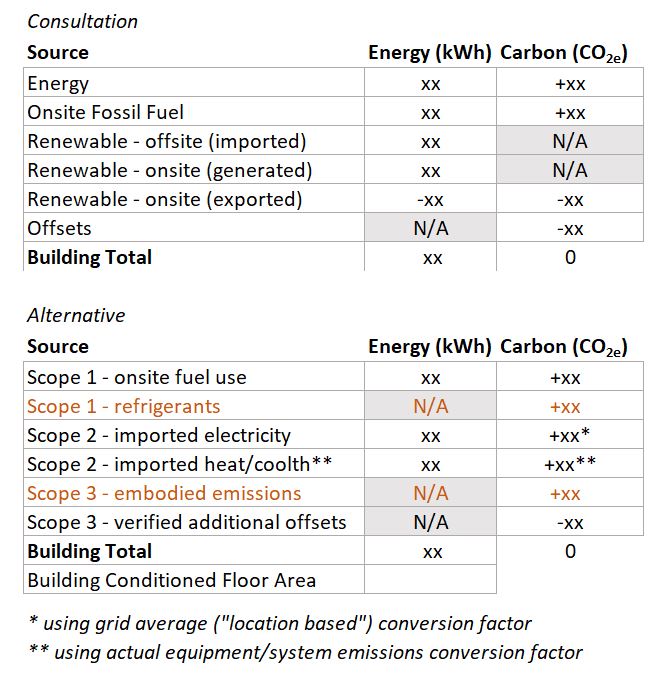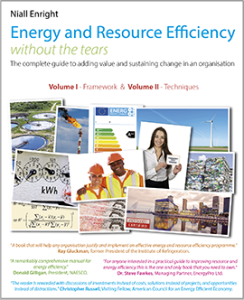 Hopefully, the definition will be a rigorous tool to help building developers and operators to achieve the maximum affordable onsite improvements in the building’s emissions. Once these onsite improvements are achieved, the definition will further set out how the residual emissions can be genuinely reduced through credible, independently verified offsite activities, leading to “net zero” or event “net negative”.
Hopefully, the definition will be a rigorous tool to help building developers and operators to achieve the maximum affordable onsite improvements in the building’s emissions. Once these onsite improvements are achieved, the definition will further set out how the residual emissions can be genuinely reduced through credible, independently verified offsite activities, leading to “net zero” or event “net negative”.
Alternatively, the definition could be a cheap and nasty fig leaf facilitating another decade of flat-line performance on emissions in the property sector.
In order to avoid the latter it is important that folks respond to the consultation on the meaning on “net zero” in buildings, which closes on the 1st March. Looking at the consultation, I would say that the outcome is finely balanced – so please do make the effort to understand the issues and make your voice heard in the consultation. Filling in a response will take around ½ hour – what better use of your time?
Getting this definition right matters because the time for inaction is over. Climate change is real, it is happening and it is proving to be very damaging. Every month since December 2014 is in the list of the top 100 warmest months recorded by NASA since January 1880. 2018 was 0.83 °C warmer than the 1951-1980 average and we are almost certain to exceed the 1.5 °C threshold which the recent IPCC Special Report says would be very dangerous to breach.
Building contribute 40% of global emissions, so effective strategies to reduce emissions in this part of our economy are critical. Reading the sustainability reports of many UK property businesses, one could be forgiven for thinking that the property sector is doing well on reducing emissions. In truth, many of these reported improvements have little to do with the efforts of the property companies themselves and are due to the dramatic decarbonisation of the UK electricity supply – or worse, as a result of “gaming the system”. In 2009, the grid average factor was 0.49 kg CO2e/kWh and today it is 0.28, a decrease of 43%.
So how is the property sector really doing? To make a fair contribution to the UK’s 2 °C maximum warming target, non-residential buildings must deliver a 58% reduction in direct emissions by 2050, compared to 1990. This translates to an interim target of a 27% reduction by 2017. The actual reduction by 2017, adjusted for weather, was 16% (CCC p94), well below where we need to be.
This should not come entirely as a surprise, given the woeful policy reversals of recent British governments, who have overseen a withdrawal or dilution of many of the measures needed to support the climate change targets. Net Zero Carbon Buildings legislation was axed, the Green Deal was so unsuccessful in the residential sector that it was never rolled out to the commercial sector, toughening of Part L efficiency standards have been delayed and support for renewable technologies have abruptly reduced on so many occasions that many building owners I know are now completely disillusioned by the prospects for on-site renewable technologies.
And yet we can only procrastinate for so long. I do sense a growing realization amongst folks on the policy front and within some property companies, that the window for action is narrowing. There is an appreciation that a 2 °C target is more dangerous that hitherto thought and we should be aiming for 1.5 °C which implies a much greater rate of decarbonization.
Cities like Manchester, where SustainSuccess is based, have already set themselves ambitious net-zero targets based on an absolute city-wide budget of 15m tonnes CO2 during the period 2018-2100, making Manchester a “zero carbon” city by 2038, which would mean a 13% reduction in emissions every year between now and then.
So, what is there is to like and dislike in the current consultation document. What are the key issues in the definition being consulted on?
Let’s start by considering the basic notion of “net zero carbon”. Of course, we all know that few buildings can be truly zero carbon in operation, let alone over their whole life cycle. Property developers have to work with what they are given – and today’s M&E industry, utilities infrastructure and investors are simply not ready or capable of adopting Passivhaus (or similar) approaches across all new build projects, and retrofitting existing properties to these standards is even more challenging if not impossible.
How then can a building which isn’t actually net zero claim to be so. For this we need to turn to the proposed “hierarchy” set out in the definition.
The intention here is that building owners would be encouraged to deliver the higher elements of the hierarchy first, staring with design features to reduce energy use (such as orientation, insulation, glazing etc) and then moving on to energy efficiency measures (such as LED lighting) and then using on-site renewables. Clearly these can take a building a long way towards zero carbon, but, in most circumstances, there is likely to be a considerable “residual” level of emissions that cannot be mitigated on site. The proposal is that these would be first addressed by procuring some of the energy used by the building from offsite renewable sources and then, if that was not sufficient, by investing in Offset projects (traditionally thought of as tree planning and similar measures).
By the way, for those with longer memories, this approach is almost identical to the one developed a decade ago, with “Allowable Solutions” being replaced with “Offsite renewables” and “Offsets”. This earlier incarnation of the Hierarchy was considered to be the lynchpin for decarbonization of the built environment until it axed by the Treasury as part of Cameron and Osborne’s “bonfire” of green regulations in 2016. This has a bearing on why the new definition is so important, so please do read on.
There are four key principles that will make the difference between an effective and a fig-leaf definition.
- There must be a minimum emissions reduction achieved onsite. This can be specified in terms of performance against the SAP/SBEM calculations, which are mandatory for new building, and against DEC/EPC ratings for existing buildings (or better ratings systems when they become available).
- Conversely, the level of onsite renewables should not be mandated, as every site is different, and export of energy from onsite renewable should not be credited towards the zero carbon calculation.
- Offsite renewables should not be permitted, except in very rare circumstances where the project is entirely funded by the building.
- Any offsite project to credit reduced emissions back to the building must demonstrate additionality – in other words, the emissions reduction must be as a result of the intervention/support by the building’s operators, and would not otherwise have happened.
I have adapted the existing wording in the consultation to cover some of these points.
“A net zero operational building should emit no carbon dioxide emissions associated with its operational energy use on an annual basis. This should be achieved by meeting minimum levels of efficiency in the building and by producing green energy on-site. Where zero onsite emissions are not possible, the residual emissions may be reduced through verified offsite emission reductions attributable to the building’s operator and which would not otherwise have taken place (i.e. actions which demonstrate additionality).”
Let’s explore each of these four points in detail.
Instinctively, I think most folks would agree that there should be a minimum level of efficiency for a building to claim net zero carbon. Otherwise a building that doesn’t meet existing standards would still be able to claim to be “net zero”. Nowadays many Local Authorities are setting requirements above the minimum standards – e.g. 35% above Part L Building Regulations is proposed for London. So, incorporating a realistic minimum level of efficiency would neither be onerous or controversial – and would prevent building owners from leaping too quickly to the offsite option.
On the other hand, I strongly support the UKGBC’s suggestion that the level of on-site renewables should not be mandated. This is because we have seen many examples where developers have been forced to install impractical systems such as biomass boilers purely to meet minimum renewable energy requirements, which subsequently are mothballed because they are uneconomic to operate.
Now on to the third point, which may be surprising to some readers. What is wrong with offsite renewable energy, one asks?
The problem is gaming of the system. Today many leading businesses, not just in the property sector, claim to be zero carbon by purchasing “green electricity”, a form of greenwashing which may have a temporary attraction in terms of the publicity value (amongst the uninformed) but has the very negative consequence of diminishing the business case and need for energy efficiency measures.
If the definition permits (let alone encourages, as currently set out) offsite renewables as a way of offsetting residual emissions, it would take less than a nanosecond for building developers and owners to realize that entering into a “green electricity” procurement deal would be a “get out of jail free” card.
Why spend money and effort on further improving a building’s fabric, equipment and onsite renewables, when a green power purchasing agreement, usually at no incremental cost, can provide all the emissions reductions needed for years to come? Many leading businesses are already using “green electricity” to flatter their performance on emission – this is not just a temptation for property developers, but also for property operators.
A problem with these green electricity tariffs is that they don’t actually get anywhere remotely close to meeting the real cost of the renewable electricity generation – this is separately paid for by all electricity users as part of the green levies on bills. In fact, every household in the UK contributed around £37 in 2015 to pay for this renewable generation (from two subsidy schemes, ROCs and FITs), together with all institutional electricity users.
The green electricity generators have to keep the ROCs or FITs associated with their green generation as these are worth a considerable amount to them and are essential for them to cover the additional cost of renewable generation compared to conventional generation. A ROC in 2018 was worth over £45 per MWh of electricity produced.
Instead, the green electricity suppliers offer the green electricity buyers REGOS (Renewable Electricity Guarantees of Origin) which, although they do prove the equivalent amount of electricity was actually produced somewhere from a renewable source, they do not signify that electricity actually supplied came from a renewable source or that a payment was made to cover the subsidy needed to enable the electricity to the produced in the first place.
If we consider that a REGO cost around 15p per MWh in the UK or less than 0.4% of the £45 subsidy required, then we can see that REGOs have no ability to stimulate renewable electricity supply. The “green electricity” market is actually a REGO market and since REGOs cost so little, the equivalent of 0.015 p/kWh, many green electricity suppliers don’t even bother to charge more for their green electricity contracts than for their conventional contract.
The further absurdity of this situation is demonstrated by the fact that a coal-fired power station can buy unwanted REGOS from another electricity supplier and so claim that their electricity is 100% renewable! The REGO market can help the most polluting generators appear green!
Some proponents for green electricity claim that, if enough folks insist on renewable electricity, then this will stimulate demand. This is nonsense and not borne out by the facts. In 2018 Electricity companies had an obligation to generate 40% of their electricity from renewable sources. In fact, they came up 13% short of this target, which resulted in penalty charges. Clearly even a £45/MWh+ penalty is not quite enough to drive the required volume of generation, so 15p is not going to have any effect. Nor is there a realistic prospect of REGOs running out – we would need 40% of all UK customer (domestic, commercial and industrial) demanding green electricity before we had any prospect of running out of REGOs and in that event there are plenty more available from other markets, such as Scandinavia, where the huge volume of hydroelectric energy means that they are plentiful and cheap (€0.05 per MWh).
If buying offsite electricity through a green tariff does not actually cover the cost of the renewable generation or stimulate additional generation, then it has no place in a claim by a building that it is zero carbon. The key concept here is “additionality”. That is to say a claim of offsite emissions reductions should only ever be made where it can be proven that the emissions reduction came about because of the intervention of the building operator. Additionality is a well-established concept in sustainability reporting and verification, so incorporating this into the net zero carbon definition is perfectly reasonable. I would describe additionality as a sort of “truth test” of any claims about emissions reduction.
Ensuring additionality protect those claiming their building are zero carbon from the accusation that they are “free riders” or “greenwashing”. As pressure to deliver emissions savings intensifies, we can be sure that there will be greater scrutiny on the veracity of claims folks are making. Incorporating additionality into the definition of “net zero carbon” will reduce potential for reputational damage to participants in the future.
So, this explains the second part of the definition we are proposing “Where zero onsite emissions are not possible, the residual emissions may be reduced through verified offsite emission reductions attributable to the building’s operator and which would not otherwise have taken place (i.e. actions which demonstrate additionality)”. Offsite generation has been deleted from the original definition and replaced with “verified offsite emissions reductions”, which, however, could include offsite renewables if the building owner fully paid for them – i.e. did not claim subsidies in the form of ROCs\CFDs\FITs etc.
It also explains the second part of the second bullet point, above. We have stated that electricity exported from on-site renewables should not be credited back to the building. The reason for this is that this electricity is likely to have received a subsidy in the form of a FIT payment, and so the building owner cannot claim to have made this emissions reduction possible through their own efforts – another example of the additionality test. This exported electricity should be ascribed to the electricity generators (and all their customers) and accounted for as part of the UK’s electricity decarbonization targets, not the building sector’s targets.
The illustration above shows our proposed hierarchy. In truth, Fabric Efficiency and Energy Efficiency are intimately linked and could, if further simplification were desired, be combined into one segment “Building Energy Efficiency”. Some apparently low carbon fabric improvements, which are rated higher than energy efficiency improvements, such as insulation, could have a high embodied carbon making them less attractive than energy efficiency measures.
If these four points are incorporated into the definition, then I think we will avoid the possibility that it will be a token measure. There are a couple of other aspects of the consultation where we had some comments and we will explore these next for the benefit of those intending to respond.
First is the proposed reporting of energy and emissions.
The consultation asks for comments on the reporting structure shown at the top of the figure above. For reasons already discussed we believe that offsite emissions and onsite renewable exports are not valid contributors to the net zero carbon definition. Furthermore, many organisations will be familiar with the Greenhouse Gas Reporting Protocol (GHGP) definition of energy and emissions into scope 1, 2 and 3 and may well be measuring these already. With that in mind we would propose the alternative table below. The two lines in orange wouldn’t be included initially, but could be considered longer-term. The important aspect is that all imported electricity would use the GHGP “location based” reporting method, i.e. “green electricity” is ruled out. We are also proposing that folks provide data on the “conditioned floor area” of their buildings, allowing building owners and operators to compare their performance in kgCO2e/m2.
Another important aspect of the consultation seeks feedback on “flexibility”. I strongly agreed with the proposition, in question 3.3, for example, that the level of “Onsite Renewables” should not be mandated – every site is very different and a tall apartment building, for example has very little roof area for solar PV, compared to terraced homes.
An area where I don’t think flexibility is warranted, is in aligning the verification of the net zero carbon claim with existing building rating systems. I can understand the temptation to do so as this could get these rating bodies on board, but we run a risk that the verification will vary from rating scheme to rating scheme, allowing building operators to “shop around” for the easiest compliance. The example given is to assert ‘Net Zero Carbon Operational for Whole Building via NABERS’ (a rating scheme originating in Australia). To clarify, while I am perfectly happy for NABERS to offer verification of “net zero carbon” as part of a wider certification process, this should be against the detailed criteria set out by UKGBC and used by all certifiers/verifiers. I don’t believe that independent third-party verification should be optional.
So why is it important that we get this definition right? Well back in the day, between 2008-12, a lot of work was done on “net zero carbon” buildings. Many planning authorities jumped on board and were using these ideas as the basis for planning approval for new developments or major refurbishments. In effect the net zero definition became the de facto basis of assessing building performance against climate change policy at a local level. Fast forward to today, and we can see Local Authorities (LAs) such as the Greater London Authority and Greater Manchester Combined Authorities setting up Carbon Offset Funds. The basis for these funds is that property developers will make good “any shortfall in carbon emissions from new development” (GLA) by supporting projects in these Funds.
The work of the UKGBC on a definition of “net zero” can form the basis for assessing the carbon performance of a building and hence the “shortfall” to be delivered offsite through these Offset Funds. This is the opportunity for the buildings sector to come up with a consistent national definition rather than having to deal with piecemeal local regulation. Furthermore, by requiring additionality and verification, the building owners can ensure that their contributions have a genuine local benefit and emissions reduction funds are not simply channelled to projects which would otherwise have happened, so diminishing the overall value of these contributions.
Critically, the Local Authorities will be tasked with coming up with affordable offsite solutions. Just as existing Section 106 payments can only happen if they don’t undermine a development’s commercial returns, then so too with the Carbon Offset Funds. This means that relatively expensive decarbonization projects, such as tree planting, may have to yield to less sexy but much cheaper measures such as insulation of public housing. While LA Funds should be the first point of call for the Offsite solutions, I would favour allowing building owners to secure their solutions from any Fund (from any LA or other provider), which will ensure that the most impactful projects can be supported earlier (which is important from an emissions reduction perspective).
I would urge the UKGBC to adopt a rigorous and detailed methodology designed to support all building developers and operators to drive substantial emissions reductions in the short term, which is essential for our survival. I would strike out word like “preferably” in the definition and I would encourage the most rigorous and defensible measurement which will protect the buildings sector from accusations that it is not pulling its weight in addressing climate change. We cannot procrastinate any longer, we need to be bold now, today.
This blogpost may have unwittingly given the impression that SustainSuccess disagrees with much of the consultation suggestions. In fact, we find we agree with many of the recommendations and warmly applaud the UKGBC and WGBC for their work in this area. It is our passion for this scheme to succeed that has prompted this feedback. You can see the actual consultation response here.
We may also have created an impression that property owners are uniformly looking for ways to duck their commitments on climate change by gaming any system. In my experience many property businesses are demonstrating great leadership in this area. The problem is that, unless the bar is raised for all, these leaders are constantly placed on the back foot to justify their efforts to investors, tenants and other stakeholders. By closing loopholes, we are supporting those diligent and committed organisations who do not game the system, who are not “free riding”, but rather work tirelessly year on year to do what is right for their tenants, shareholders and for the planet.
They, I firmly believe, will welcome a rigorous definition along the lines of our proposal, which will support the property sector to achieve the levels of emissions reductions needed for our collective survival and with that the long-term interest of their organisation.
I hope you will take the time to respond to this very important consultation and share this post with others. I would warmly welcome comments and feedback.






0 Comments